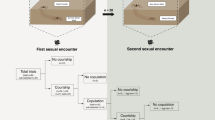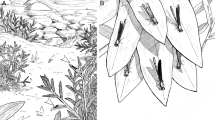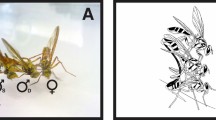Abstract
In many diverse taxa, males of the same species often exhibit multiple mating strategies1. One well-documented alternative male reproductive pattern is ‘female mimicry’, whereby males assume a female-like morphology2–8 or mimic female behaviour patterns9,10. In some species males mimic both female morphology and behaviour2,7,11,12. We report here female mimicry in a reptile, the red-sided garter snake (Thamnophis sirtalis parietalis). This form of mimicry is unique in that it is expressed as a physiological feminization. Courting male red-sided garter snakes detect a female-specific pheromone and normally avoid courting other males. However, a small proportion of males release a pheromone that attracts other males, as though they were females. In the field, mating aggregations of 5–17 males were observed formed around these individual attractive males, which we have termed ‘she-males’. In competitive mating trails, she-males mated with females significantly more often than did normal males, demonstrating not only reproductive competence but also a possible selective advantage to males with this female-like pheromone.
This is a preview of subscription content, access via your institution
Access options
Subscribe to this journal
Receive 51 print issues and online access
$199.00 per year
only $3.90 per issue
Buy this article
- Purchase on Springer Link
- Instant access to full article PDF
Prices may be subject to local taxes which are calculated during checkout
Similar content being viewed by others
References
Halliday, T. Sexual Strategy (Oxford University Press, 1980).
Gross, M. R. & Charnov, E. L. Proc. natn. Acad. Sci. U.S.A. 77, 6937–6940 (1980).
Morris, D. Behavior 4, 232–261 (1952).
Gross, M. R., J. Zool. 57, 1507–1509 (1979).
Gross, M. R. Z. Tierpsychol. 60, 1–26 (1982).
Dominey, W. Nature 284, 546–548 (1980).
Gross, M. R. in Fish Reproduction: Strategies and Tactics (eds Wootton, R. J. & Potts, G.) 55–75 (Academic, London, 1984).
Gross, M. R. Nature 313, 47–48 (1985).
Thornhill, R. Science 205, 412–414 (1979).
Arnold, S. J. Z. Tierpsychol. 42, 247–300 (1976).
Dominey, W. Am. Zool. 24, 385–396 (1984).
Weldon, P. J. & Burghardt, G. M. Z. Tierpsychol. 65, 89–102 (1984).
Nobel, G. K. Bull. Am. Mus. nat. Hist. 73, 673–725 (1937).
Crews, D. Horm. Behav. 7, 451–460 (1976).
Garstka, W. & Crews, D. Science 214, 681–683 (1981).
Bona-Gallo, A. & Licht, P. Herpetologica 39(2), 173–182 (1983).
Camazine, B., Garstka, W., Tokarz, R. & Crews, D. Horm. Behav. 14, 358–372 (1980).
Author information
Authors and Affiliations
Rights and permissions
About this article
Cite this article
Mason, R., Crews, D. Female mimicry in garter snakes. Nature 316, 59–60 (1985). https://doi.org/10.1038/316059a0
Received:
Accepted:
Issue Date:
DOI: https://doi.org/10.1038/316059a0
This article is cited by
-
Aggregation and social interaction in garter snakes (Thamnophis sirtalis sirtalis)
Behavioral Ecology and Sociobiology (2020)
-
Feminization of Male Brown Treesnake Methyl Ketone Expression via Steroid Hormone Manipulation
Journal of Chemical Ecology (2018)
-
Pheromonal Mediation of Intraseasonal Declines in the Attractivity of Female Red-Sided Garter Snakes, Thamnophis sirtalis parietalis
Journal of Chemical Ecology (2012)
-
Facultative pheromonal mimicry in snakes: “she-males” attract courtship only when it is useful
Behavioral Ecology and Sociobiology (2012)
-
Social behavior and pheromonal communication in reptiles
Journal of Comparative Physiology A (2010)
Comments
By submitting a comment you agree to abide by our Terms and Community Guidelines. If you find something abusive or that does not comply with our terms or guidelines please flag it as inappropriate.



